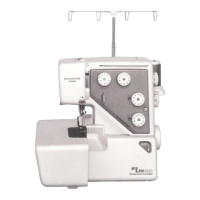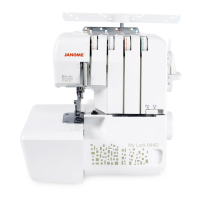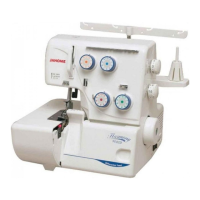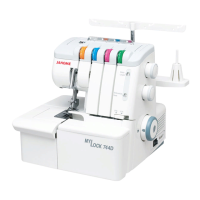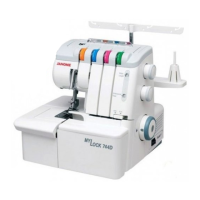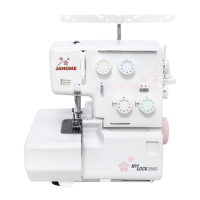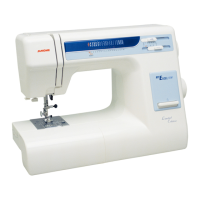Do you have a question about the Janome MyLock 203 and is the answer not in the manual?
Guidelines to prevent electric shock hazards, including unattended operation and water contact.
Precautions for safe operation, including child safety, proper use, and avoiding damage.
Diagram and labels for all external parts of the Janome MyLock 203 serger.
List and illustrations of items included with the sewing machine.
Instructions for attaching and storing the optional waste chip box.
Steps for connecting the sewing machine to the electrical power outlet.
How to adjust and use the foot controller for variable sewing speeds.
Correct direction and method for turning the machine's balance wheel.
Instructions for accessing and closing the side and looper covers.
Guidance on adjusting the thread guide bar for proper thread path.
Instructions for attaching discs and nets to prevent thread jamming.
How to raise and lower the presser foot, and when to keep it lowered.
Overview of the machine threading process and importance of correct threading.
Detailed instructions for threading the lower looper with diagrams.
Final steps for threading the lower looper, including using the threader.
Specific guidance for threading woolly nylon or polyester threads in the lower looper.
Detailed instructions for threading the upper looper with diagrams.
Final steps for threading the upper looper, including using the threader.
Detailed instructions for threading the needle with diagrams.
Final steps for needle threading, including using the needle threader and closing covers.
How to start sewing, feed fabric, and continue sewing without stopping.
Procedure for completing a seam, creating a thread chain, and cutting threads.
Techniques to prevent seams from unravelling at the beginning, including backstitching.
Techniques to prevent seams from unravelling at the end of sewing.
Diagram and explanation of the thread tension dials and their settings.
Visual guide showing correct thread tension on the right and wrong sides of fabric.
Guidance for adjusting needle thread tension when it is loose.
Guidance for adjusting upper and lower looper thread tensions for balance.
How to set and adjust the stitch length dial for different sewing needs.
How to adjust the presser foot pressure for various fabric types.
Step-by-step instructions for safely removing the presser foot.
Step-by-step instructions for correctly attaching a new presser foot.
Procedure for removing and inserting a new sewing machine needle.
Steps to disengage the upper knife for specific sewing tasks.
Instructions on how to re-engage the upper knife after deactivation.
Overview of different needle plates and their uses for various seams.
Detailed steps for replacing the needle plate with a different type.
How to adjust the machine for different seam widths using the lower knife.
Chart detailing recommended threads and needles for various fabric types and seam widths.
Machine settings for stitch length and needle plate for rolled hemming.
Machine settings for stitch length and needle plate for picot edging.
Machine settings for stitch length and needle plate for narrow hemming.
Guidance on thread, fabric, and tension dial settings for decorative overedging.
Recommended stitch length, seam width, and needle plate for overedging.
Recommendations for thread, fabric, and machine settings for pin tucking.
Instructions for sewing pin tucks, including knife deactivation and guiding the fabric.
Step-by-step guide to safely remove the upper knife from the machine.
Step-by-step guide to correctly install the upper knife, including alignment.
How to clean lint and debris from around the upper knife.
Instructions for cleaning lint and debris from the feed dog mechanism.
Steps for safely removing and replacing the sewing machine light bulb.
Diagrams showing where to oil the machine and recommended oiling frequency.
Solutions for fabric not feeding smoothly or needle breaks.
Troubleshooting for thread breaks and skipped stitches.
Addressing problems like seam puckering, machine not operating, and fabric cut issues.
Guidelines to prevent electric shock hazards, including unattended operation and water contact.
Precautions for safe operation, including child safety, proper use, and avoiding damage.
Diagram and labels for all external parts of the Janome MyLock 203 serger.
List and illustrations of items included with the sewing machine.
Instructions for attaching and storing the optional waste chip box.
Steps for connecting the sewing machine to the electrical power outlet.
How to adjust and use the foot controller for variable sewing speeds.
Correct direction and method for turning the machine's balance wheel.
Instructions for accessing and closing the side and looper covers.
Guidance on adjusting the thread guide bar for proper thread path.
Instructions for attaching discs and nets to prevent thread jamming.
How to raise and lower the presser foot, and when to keep it lowered.
Overview of the machine threading process and importance of correct threading.
Detailed instructions for threading the lower looper with diagrams.
Final steps for threading the lower looper, including using the threader.
Specific guidance for threading woolly nylon or polyester threads in the lower looper.
Detailed instructions for threading the upper looper with diagrams.
Final steps for threading the upper looper, including using the threader.
Detailed instructions for threading the needle with diagrams.
Final steps for needle threading, including using the needle threader and closing covers.
How to start sewing, feed fabric, and continue sewing without stopping.
Procedure for completing a seam, creating a thread chain, and cutting threads.
Techniques to prevent seams from unravelling at the beginning, including backstitching.
Techniques to prevent seams from unravelling at the end of sewing.
Diagram and explanation of the thread tension dials and their settings.
Visual guide showing correct thread tension on the right and wrong sides of fabric.
Guidance for adjusting needle thread tension when it is loose.
Guidance for adjusting upper and lower looper thread tensions for balance.
How to set and adjust the stitch length dial for different sewing needs.
How to adjust the presser foot pressure for various fabric types.
Step-by-step instructions for safely removing the presser foot.
Step-by-step instructions for correctly attaching a new presser foot.
Procedure for removing and inserting a new sewing machine needle.
Steps to disengage the upper knife for specific sewing tasks.
Instructions on how to re-engage the upper knife after deactivation.
Overview of different needle plates and their uses for various seams.
Detailed steps for replacing the needle plate with a different type.
How to adjust the machine for different seam widths using the lower knife.
Chart detailing recommended threads and needles for various fabric types and seam widths.
Machine settings for stitch length and needle plate for rolled hemming.
Machine settings for stitch length and needle plate for picot edging.
Machine settings for stitch length and needle plate for narrow hemming.
Guidance on thread, fabric, and tension dial settings for decorative overedging.
Recommended stitch length, seam width, and needle plate for overedging.
Recommendations for thread, fabric, and machine settings for pin tucking.
Instructions for sewing pin tucks, including knife deactivation and guiding the fabric.
Step-by-step guide to safely remove the upper knife from the machine.
Step-by-step guide to correctly install the upper knife, including alignment.
How to clean lint and debris from around the upper knife.
Instructions for cleaning lint and debris from the feed dog mechanism.
Steps for safely removing and replacing the sewing machine light bulb.
Diagrams showing where to oil the machine and recommended oiling frequency.
Solutions for fabric not feeding smoothly or needle breaks.
Troubleshooting for thread breaks and skipped stitches.
Addressing problems like seam puckering, machine not operating, and fabric cut issues.
| Type | Overlock |
|---|---|
| Differential Feed | Yes |
| Free Arm | No |
| Built-in Rolled Hem | Yes |
| Needle Threader | No |
| Number of Threads | 3/4 |
| Stitch Length | 1 - 4 mm |
| Stitch Types | Overlock, rolled hem |

